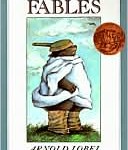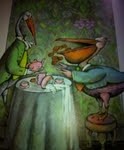
There’s a delightfully funny and clever fable, The Pelican and the Crane, by Arnold Lobel… as part of Lobel’s Caldecott Medal award-winning book FABLES…

This fable tells us of a friendly, yet proper Crane who invites a Pelican to tea. The Pelican immediately accepts the Crane’s invitation, saying that no-one invites him anywhere.
The Crane is a fine tea party host and sets a delightful table-clothed setting of tea-ware, sugar, milk and cookies…

At the tea and during tea conversation about the Pelican never being called to visit anywhere, the Pelican proceeds to spill a half sugar bowl of sugar, pours milk on the table, stuffs a pile of cookies into his mouth and wipes his mouth on the Crane’s tablecloth… all the while wondering aloud why nobody ever calls.
At the tea’s end, the Pelican says that he hopes to be invited again.
The gracious Crane replies, ever so politely “… but I am so very busy these days.”
Author Arnold Lobel fills us in with the moral of the story: When one is a social failure, the reasons are as clear as day.
What we discover in The Pelican and the Crane is a wonderful message that manners and etiquette are important.
But what is the real tweet-tweet on the Crane in real-life ? Here are a few little tidbits to pass along to your kids and grandkids to combine literature and life:
– The Crane is a large, long-legged and long-necked bird.
– The Crane has a streamlined body and long, rounded wings. When it flies, the Crane forms a straight line from its bill to its toes, making it one of the most elegant and graceful birds in flight.
– Some Cranes are among the tallest birds in the world.
– The Crane is known for its dances… as both mating rituals and just for fun. When one Crane decides to dance, other members of the flock quickly join in.
– Cranes have definite patterns to their dances, often containing detailed leaps, bows and runs. Dances are often accompanied with feathers, sticks, and other small objects… tossed from the bills of the Cranes.
– The courtship dance of the Whooping Crane is considered the great show of nature. The dance involves strutting, leaping, wing flapping, bowing and loud whooping.
– Cranes are very social birds, living in sometimes very large flocks.
– Cranes mate for life. The female lays 2 – 4 eggs in a clutch, but more often just 2. One chick generally survives.
– A Crane chick’s coloring (light brown or gray) provides camouflage from predators. The chick is fed by its parents as soon as it hatches. Chicks grow very quickly and develop flight feathers at 2 – 4 months.
– Cranes have very good vocal communication systems. Each Crane species has its own volume and tone… from honks to flute-like sounds to the unmistakably haunting, bugle-like call of the Whooping Crane.
– Crane chicks learn their species’ call as soon as they hatch.
– Cranes also have excellent communication skills in social situations. An aggressive Crane is known to stand very tall, flap its wings, walk stiffly and growl. A submissive Crane is known to lower its head and tread softly.
– Some Crane species migrate great distances (200 – 500 miles per day) at great altitudes (as high as 6,500 feet)… forming V formations, gliding and communicating the entire trip.
– The Eurasian Crane flies over the Himalaya Mountains at altitudes of almost 33,000 feet. Yikes!
– The Whooping Crane was one of the first species to be protected by the Endangered Species Act of 1973.
Ah. The Crane in real-life.
Reading the fable The Pelican and the Crane with your kids and grandkids, with a little knowledge of the Crane in real-life, gives you so much to discuss… and your kids so much to think about as they embrace the literature.
Do you think the elegant, gracious Crane in the fable is as elegant and social as a real-life Crane? Do you think author Arnold Lobel chose a good character in the Crane?
The fable also gives us a great opportunity to talk with our kids about manners, social behavior, etiquette, invitations… and whom we would invite back for “tea”!
Join me here each day in August for AUGUST TWEET-TWEETS on 365 Days of Literacy for Kids! A little fun, a little learning and a bit of “tweet-tweet”!



